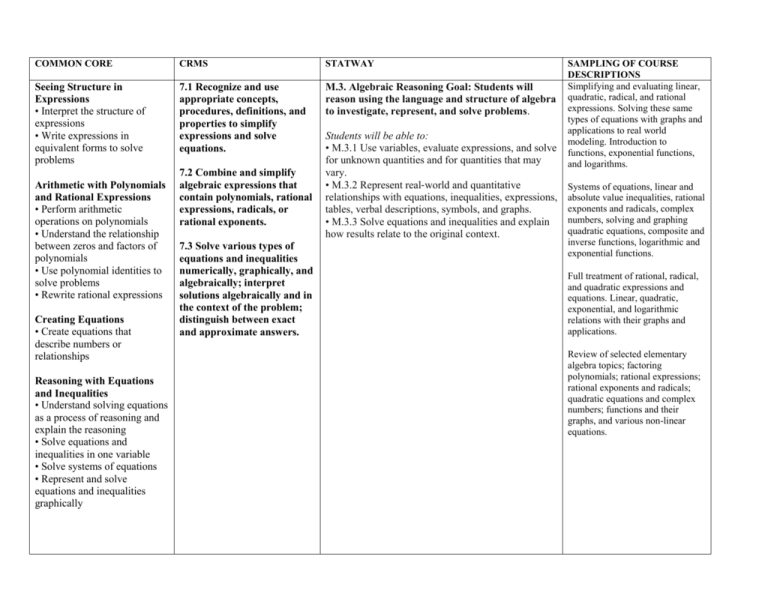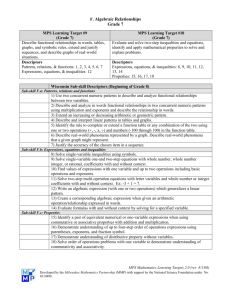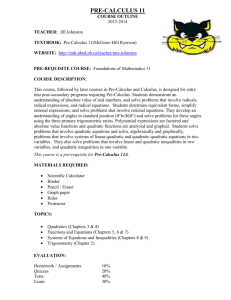Math Conference Session Notes (Nevins)v2
advertisement

COMMON CORE CRMS STATWAY Seeing Structure in Expressions • Interpret the structure of expressions • Write expressions in equivalent forms to solve problems 7.1 Recognize and use appropriate concepts, procedures, definitions, and properties to simplify expressions and solve equations. M.3. Algebraic Reasoning Goal: Students will reason using the language and structure of algebra to investigate, represent, and solve problems. Arithmetic with Polynomials and Rational Expressions • Perform arithmetic operations on polynomials • Understand the relationship between zeros and factors of polynomials • Use polynomial identities to solve problems • Rewrite rational expressions Creating Equations • Create equations that describe numbers or relationships Reasoning with Equations and Inequalities • Understand solving equations as a process of reasoning and explain the reasoning • Solve equations and inequalities in one variable • Solve systems of equations • Represent and solve equations and inequalities graphically 7.2 Combine and simplify algebraic expressions that contain polynomials, rational expressions, radicals, or rational exponents. 7.3 Solve various types of equations and inequalities numerically, graphically, and algebraically; interpret solutions algebraically and in the context of the problem; distinguish between exact and approximate answers. Students will be able to: • M.3.1 Use variables, evaluate expressions, and solve for unknown quantities and for quantities that may vary. • M.3.2 Represent real‐world and quantitative relationships with equations, inequalities, expressions, tables, verbal descriptions, symbols, and graphs. • M.3.3 Solve equations and inequalities and explain how results relate to the original context. SAMPLING OF COURSE DESCRIPTIONS Simplifying and evaluating linear, quadratic, radical, and rational expressions. Solving these same types of equations with graphs and applications to real world modeling. Introduction to functions, exponential functions, and logarithms. Systems of equations, linear and absolute value inequalities, rational exponents and radicals, complex numbers, solving and graphing quadratic equations, composite and inverse functions, logarithmic and exponential functions. Full treatment of rational, radical, and quadratic expressions and equations. Linear, quadratic, exponential, and logarithmic relations with their graphs and applications. Review of selected elementary algebra topics; factoring polynomials; rational expressions; rational exponents and radicals; quadratic equations and complex numbers; functions and their graphs, and various non-linear equations. Interpreting Functions • Understand the concept of a function and use function notation • Interpret functions that arise in applications in terms of the context • Analyze functions using different representations Building Functions • Build a function that models a relationship between two quantities • Build new functions from existing functions Linear, Quadratic, and Exponential Models • Construct and compare linear, quadratic, and exponential models and solve problems • Interpret expressions for functions in terms of the situation they model Trigonometric Functions • Extend the domain of trigonometric functions using the unit circle • Model periodic phenomena with trigonometric functions • Prove and apply trigonometric identities 8.1 Recognize functional relationships presented in words, tables, graphs, and symbols. 8.2 Represent basic functions (linear, quadratic, exponential, and reciprocal) and piecewise-defined functions (varying over subintervals of the domain) using and translating among words, tables, graphs, and symbols. 8.3 Analyze and interpret features of a function. 8.4 Model situations and relationships using a variety of basic functions (linear, quadratic, logarithmic, exponential, and reciprocal) and piecewise-defined functions. a. Choose a function suitable for modeling a real world situation presented using words or data. b. Determine and interpret the meaning of rates of change, intercepts, zeros, extrema, and trends. c. Abstract mathematical models from word problems and interpret solutions in the context of these source problems. d. Identify and justify whether a result obtained from a function model has real world significance. M.4. Functions and Modeling Goal: Students will understand functions as a way of modeling a correspondence between two variables. Students will be able to represent functions in various ways: verbally, algebraically, and graphically. Students will be able to: • M.4.1 Represent a function algebraically and be able to compute values of a function. • M.4.2 Describe a function verbally, algebraically, graphically, and in a table of values, and make connections among representations. • M.4.3 Make conjectures about the behavior of a function given several values of the function and a given context. • M.4.4 Model situations with linear, quadratic, and exponential functions, inequalities and equations. • M.4.5 Be able to investigate graphically and numerically (with technology) the effect of changing a parameter within a model. • M.4.6 For linear functions, students will be able to: a. Use linear functions to model situations involving constant rates of change. b. Describe the constant of proportionality, slope, as the rate of change of the function using appropriate units. c. Given the graph, an equation, or two or more points on a line, determine and interpret the intercept(s) and slope. d. Given a set of points that exhibit a linear trend, determine the line of best fit. e. Compute and interpret the errors or deviation from a line of best fit that is used to model a data set with a linear trend. • M 4.7 For exponential functions, students will be able to: a. Identify and quantify exponential growth or decay in formulas, graphs, tables, and applications. b. Characterize and describe exponential models and compare them to other models. c. Use exponential functions to represent relationships between variables in involving exponential growth and decay. d. Describe transformations of the graphs of exponential functions. AMATYC CROSSROADS Standard C-2: Symbolism and Algebra Students will translate problem situations into their symbolic representations and use those representations to solve problems. Students will move beyond concrete numerical operations to use abstract concepts and symbols to solve problems. Students will represent mathematical situations symbolically and use a combination of appropriate algebraic, graphical, and numerical methods to form conjectures about the problems. Suggested topics include derivation of formulas, translation of realistic problems into mathematical statements, and the solution of equations by appropriate graphical, numerical, and algebraic methods. Common Core: Additional Definitions/Descriptions Expressions. An expression is a record of a computation with numbers, symbols that represent numbers, arithmetic operations, exponentiation, and, at more advanced levels, the operation of evaluating a function. Conventions about the use of parentheses and the order of operations assure that each expression is unambiguous. Creating an expression that describes a computation involving a general quantity requires the ability to express the computation in general terms, abstracting from specific instances. Reading an expression with comprehension involves analysis of its underlying structure. This may suggest a different but equivalent way of writing the expression that exhibits some different aspect of its meaning. For example, p + 0.05p can be interpreted as the addition of a 5% tax to a price p. Rewriting p + 0.05p as 1.05p shows that adding a tax is the same as multiplying the price by a constant factor. Algebraic manipulations are governed by the properties of operations and exponents, and the conventions of algebraic notation. At times, an expression is the result of applying operations to simpler expressions. For example, p + 0.05p is the sum of the simpler expressions p and 0.05p. Viewing an expression as the result of operation on simpler expressions can sometimes clarify its underlying structure. A spreadsheet or a computer algebra system (CAS) can be used to experiment with algebraic expressions, perform complicated algebraic manipulations, and understand how algebraic manipulations behave. Equations and inequalities. An equation is a statement of equality between two expressions, often viewed as a question asking for which values of the variables the expressions on either side are in fact equal. These values are the solutions to the equation. An identity, in contrast, is true for all values of the variables; identities are often developed by rewriting an expression in an equivalent form. The solutions of an equation in one variable form a set of numbers; the solutions of an equation in two variables form a set of ordered pairs of numbers, which can be plotted in the coordinate plane. Two or more equations and/or inequalities form a system. A solution for such a system must satisfy every equation and inequality in the system. An equation can often be solved by successively deducing from it one or more simpler equations. For example, one can add the same constant to both sides without changing the solutions, but squaring both sides might lead to extraneous solutions. Strategic competence in solving includes looking ahead for productive manipulations and anticipating the nature and number of solutions. Some equations have no solutions in a given number system, but have a solution in a larger system. For example, the solution of x + 1 = 0 is an integer, not a whole number; the solution of 2x + 1 = 0 is a rational number, not an integer; the solutions of x2 – 2 = 0 are real numbers, not rational numbers; and the solutions of x2 + 2 = 0 are complex numbers, not real numbers. The same solution techniques used to solve equations can be used to rearrange formulas. For example, the formula for the area of a trapezoid, A = ((b1+b2)/2)h, can be solved for h using the same deductive process. Inequalities can be solved by reasoning about the properties of inequality. Many, but not all, of the properties of equality continue to hold for inequalities and can be useful in solving them. Connections to Functions and Modeling. Expressions can define functions, and equivalent expressions define the same function. Asking when two functions have the same value for the same input leads to an equation; graphing the two functions allows for finding approximate solutions of the equation. Converting a verbal description to an equation, inequality, or system of these is an essential skill in modeling. Functions. Functions describe situations where one quantity determines another. For example, the return on $10,000 invested at an annualized percentage rate of 4.25% is a function of the length of time the money is invested. Because we continually make theories about dependencies between quantities in nature and society, functions are important tools in the construction of mathematical models. In school mathematics, functions usually have numerical inputs and outputs and are often defined by an algebraic expression. For example, the time in hours it takes for a car to drive 100 miles is a function of the car’s speed in miles per hour, v; the rule T(v) = 100/v expresses this relationship algebraically and defines a function whose name is T. The set of inputs to a function is called its domain. We often infer the domain to be all inputs for which the expression defining a function has a value, or for which the function makes sense in a given context. A function can be described in various ways, such as by a graph (e.g., the trace of a seismograph); by a verbal rule, as in, “I’ll give you a state, you give me the capital city;” by an algebraic expression like f(x) = a + bx; or by a recursive rule. The graph of a function is often a useful way of visualizing the relationship of the function models, and manipulating a mathematical expression for a function can throw light on the function’s properties. Functions presented as expressions can model many important phenomena. Two important families of functions characterized by laws of growth are linear functions, which grow at a constant rate, and exponential functions, which grow at a constant percent rate. Linear functions with a constant term of zero describe proportional relationships. A graphing utility or a computer algebra system can be used to experiment with properties of these functions and their graphs and to build computational models of functions, including recursively defined functions. Connections to Expressions, Equations, Modeling, and Coordinates. Determining an output value for a particular input involves evaluating an expression; finding inputs that yield a given output involves solving an equation. Questions about when two functions have the same value for the same input lead to equations, whose solutions can be visualized from the intersection of their graphs. Because functions describe relationships between quantities, they are frequently used in modeling. Sometimes functions are defined by a recursive process, which can be displayed effectively using a spreadsheet or other technology. Mathematical Practices 1. Make sense of problems and persevere in solving them. 2. Reason abstractly and quantitatively. 3. Construct viable arguments and critique the reasoning of others. 4. Model with mathematics. 5. Use appropriate tools strategically. 6. Attend to precision. 7. Look for and make use of structure. 8. Look for and express regularity in repeated reasoning.








